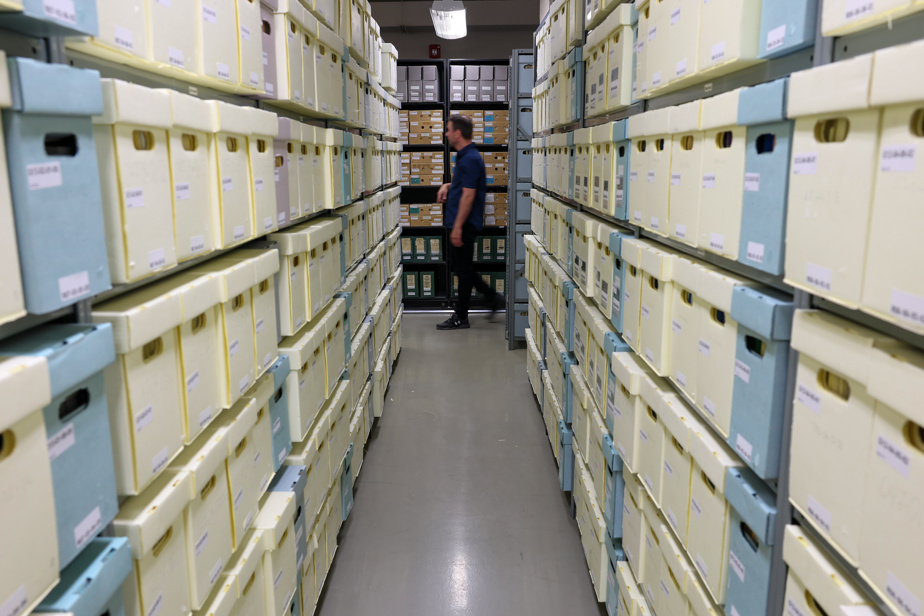Is your 30 box move causing you headaches? Imagine having 30,000 to move.
This is the task that Montreal’s municipal archives are tackling these days, which are returning to a newly renovated city hall after six years of absence. A deadline which stretched with the delay in the work.
At the end of May, during the visit of The Press in the temporary premises on rue Saint-Denis, everything was ready for the move. On each box: three digital codes. Its former location at city hall, its temporary location and its future location upon its return to the depot.

PHOTO FRANÇOIS ROY, THE PRESS
Archivist Nicolas Bednarz
The archives of the City of Montreal are “5.6 kilometers of documents, approximately 2,000,000 photos,” explains archivist Nicolas Bednarz.
The documents trace the evolution of Montreal since 1642, but especially since the constitution of its first civil administration in 1796.
No question of misplacing or storing away all these memories as some movers have a reputation.
The dual objective “is to ensure the integrity of the documents and to find them,” explained division head Florian Daveau.
Hundreds of glass negatives, for example, will have to be moved even though they are “very fragile”. “Movers have very specific instructions. You have to be careful with all the boxes, but for these, there are special instructions, he continued. There is always an archivist or technician who will be with the movers to ensure that these documents arrive in good condition. »

PHOTO FRANÇOIS ROY, THE PRESS
Florian Daveau, head of the Document Management and Archives Division of the City of Montreal
The challenge is very much spotting. It’s like a big puzzle that you mix up and do differently.
Florian Daveau, head of the Document Management and Archives Division of the City of Montreal

PHOTO FRANÇOIS ROY, THE PRESS
June 1833, the election of Jacques Viger, first mayor of Montreal, was recorded.
“Endless Excel files”
The archives did not sleep during their years on rue Saint-Denis, in a former industrial building located on the corner of boulevard Rosemont. Researchers and municipal officials continued to consult the documents they needed, in person or – for those that had been digitized – via the internet.
However, it is not assisting researchers that has taken up most of the archivists’ time in recent weeks. “Since January, we have been working almost daily” on the move, said Mr. Daveau. In endless Excel files, the 30,000 boxes and their 216,000 sets of documents are listed.

PHOTO FRANÇOIS ROY, THE PRESS
Certain objects require special attention when moving, such as glass negatives.
Planning remains the key to a successful transfer, according to him and his colleague. No boxes were lost in the move from city hall to Saint-Denis Street, but “to be very honest, there were some that took a little time” to locate, said Nicolas Bednarz. “I’m quite proud. »
Three trucks will travel back and forth between the two locations throughout the month of June.
-

PHOTO FRANÇOIS ROY, THE PRESS
Some of the period documents in the Montreal archives
-

PHOTO FRANÇOIS ROY, THE PRESS
Some of the period documents in the Montreal archives
-

PHOTO FRANÇOIS ROY, THE PRESS
Some of the period documents in the Montreal archives
-

PHOTO FRANÇOIS ROY, THE PRESS
Some of the period documents in the Montreal archives
1/4
Refurbished vaults
This is not the first upheaval at Montreal city hall that the municipal archives have experienced. In 1922, the building burned to the ground, around fifty years after its construction.
The bulk of the archives, however, escaped unscathed: an underground vault had been built under the square in front of the building in 1919. “The documents had been transferred gradually between 1919 and 1922,” said Mr. Bednarz. It’s lucky, really. […] We have photographs of the opening of the doors which closed the vaults. We see the documents, everything around them is destroyed. »
A second underground vault was built next door in the 1950s.

PHOTO FRANÇOIS ROY, THE PRESS
Registers, photographs, maps – like this one of Sainte-Hélène Island dating from 1937 – moving the entire archive takes months of planning.
It is to these two spaces that the archives are returning at this very moment. However, they have been rearranged, allowing archivists to gain approximately 20% additional space. The price for the efforts invested by the archives teams since 2018.
“A move like that is once every 100 years,” assured Florian Daveau. In 2124, the records will be able to tell if he was wrong.
